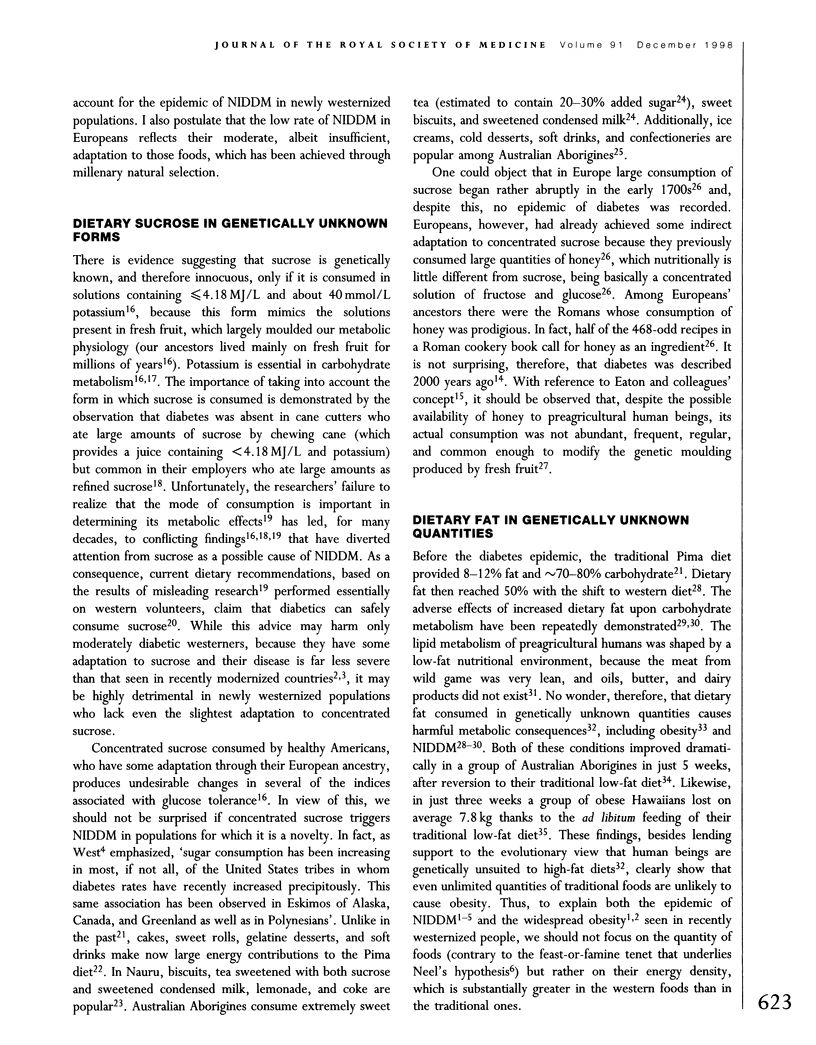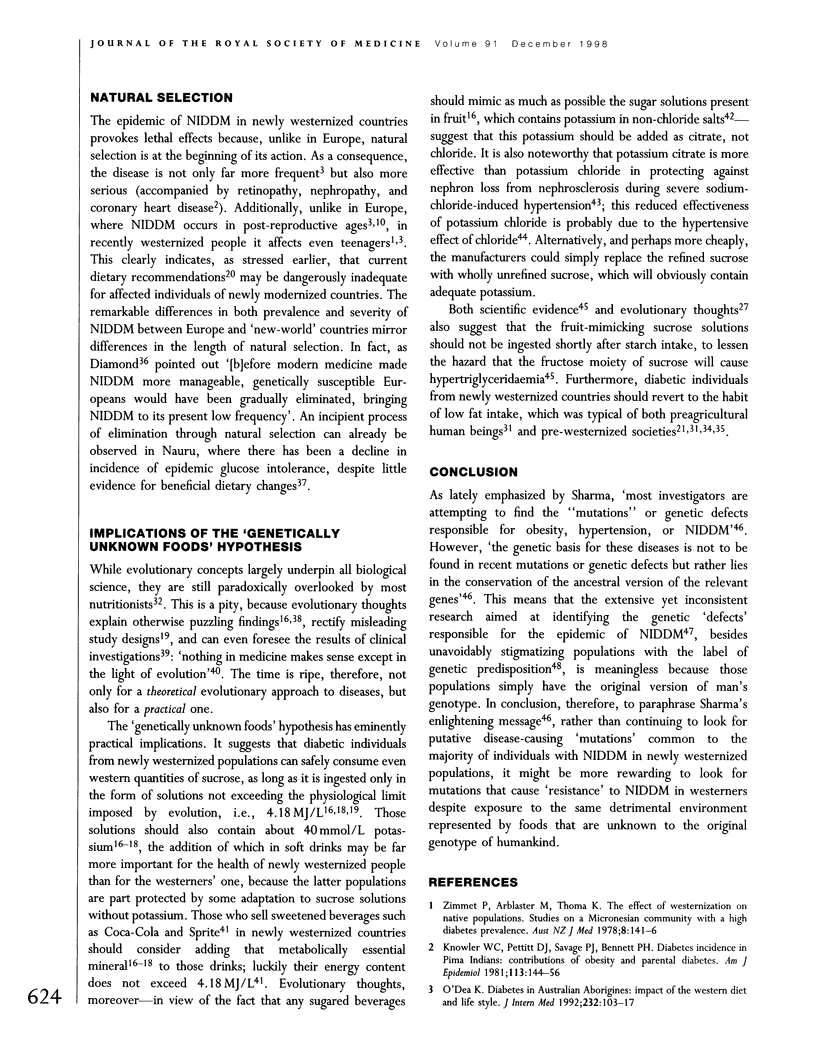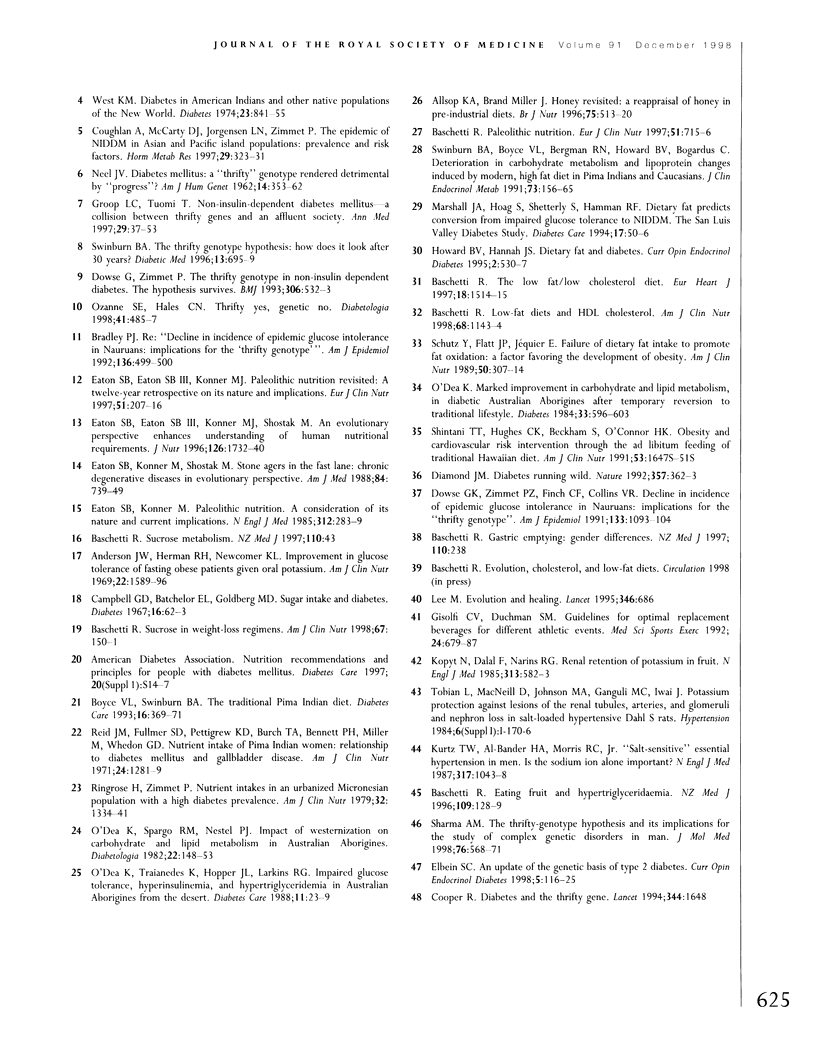Abstract
Until a few decades ago, certain 'new-world' populations that kept to traditional dietary habits were virtually free from diabetes; then, after they began eating some foods that are common in Europe, the disease reached epidemic proportions. Europeans, by contrast, have a low rate of diabetes. To account for this paradox, it has been suggested that those new-world populations have a thrifty genotype, which would have conferred a selective advantage during the frequent famines of the past, while today it would be detrimental because the recently adopted foods are constantly available. Here it is proposed that thrifty genes are unlikely to exist. Both the diabetes epidemics that occur in newly westernized populations and the low rate of diabetes in Europeans can be explained by the hypothesis that Europeans, through millenary natural selection, have become adapted, albeit incompletely, to some diabetogenic foods for which humankind is genetically unequipped.
Full text
PDF



Selected References
These references are in PubMed. This may not be the complete list of references from this article.
- Allsop K. A., Miller J. B. Honey revisited: a reappraisal of honey in pre-industrial diets. Br J Nutr. 1996 Apr;75(4):513–520. doi: 10.1079/bjn19960155. [DOI] [PubMed] [Google Scholar]
- Anderson J. W., Herman R. H., Newcomer K. L. Improvement in glucose tolerance of fasting obese patients given oral potassium. Am J Clin Nutr. 1969 Dec;22(12):1589–1596. doi: 10.1093/ajcn/22.12.1589. [DOI] [PubMed] [Google Scholar]
- Baschetti R. Eating fruit and hypertriglyceridaemia. N Z Med J. 1996 Apr 12;109(1019):128–129. [PubMed] [Google Scholar]
- Baschetti R. Gastric emptying: gender differences. N Z Med J. 1997 Jun 27;110(1046):238–238. [PubMed] [Google Scholar]
- Baschetti R. Low-fat diets and HDL cholesterol. Am J Clin Nutr. 1998 Nov;68(5):1143–1144. doi: 10.1093/ajcn/68.5.1143. [DOI] [PubMed] [Google Scholar]
- Baschetti R. Paleolithic nutrition. Eur J Clin Nutr. 1997 Oct;51(10):715–716. doi: 10.1038/sj.ejcn.1600471. [DOI] [PubMed] [Google Scholar]
- Baschetti R. Sucrose in weight-loss regimens. Am J Clin Nutr. 1998 Jan;67(1):150–151. doi: 10.1093/ajcn/67.1.150. [DOI] [PubMed] [Google Scholar]
- Baschetti R. Sucrose metabolism. N Z Med J. 1997 Feb 14;110(1037):43–43. [PubMed] [Google Scholar]
- Boyce V. L., Swinburn B. A. The traditional Pima Indian diet. Composition and adaptation for use in a dietary intervention study. Diabetes Care. 1993 Jan;16(1):369–371. doi: 10.2337/diacare.16.1.369. [DOI] [PubMed] [Google Scholar]
- Bradley P. J. Re: "Decline in incidence of epidemic glucose intolerance in Nauruans: implications for the 'thrifty genotype'". Am J Epidemiol. 1992 Aug 15;136(4):499–500. doi: 10.1093/oxfordjournals.aje.a116525. [DOI] [PubMed] [Google Scholar]
- Campbell G. D., Batchelor E. L., Goldberg M. D. Sugar intake and diabetes. Diabetes. 1967 Jan;16(1):62–63. doi: 10.2337/diab.16.1.62. [DOI] [PubMed] [Google Scholar]
- Cooper R. Diabetes and the thrifty gene. Lancet. 1994 Dec 10;344(8937):1648–1648. doi: 10.1016/s0140-6736(94)90448-0. [DOI] [PubMed] [Google Scholar]
- Coughlan A., McCarty D. J., Jorgensen L. N., Zimmet P. The epidemic of NIDDM in Asian and Pacific Island populations: prevalence and risk factors. Horm Metab Res. 1997 Jul;29(7):323–331. doi: 10.1055/s-2007-979045. [DOI] [PubMed] [Google Scholar]
- Diamond J. M. Human evolution. Diabetes running wild. Nature. 1992 Jun 4;357(6377):362–363. doi: 10.1038/357362a0. [DOI] [PubMed] [Google Scholar]
- Dowse G. K., Zimmet P. Z., Finch C. F., Collins V. R. Decline in incidence of epidemic glucose intolerance in Nauruans: implications for the "thrifty genotype". Am J Epidemiol. 1991 Jun 1;133(11):1093–1104. doi: 10.1093/oxfordjournals.aje.a115822. [DOI] [PubMed] [Google Scholar]
- Dowse G., Zimmet P. The thrifty genotype in non-insulin dependent diabetes. BMJ. 1993 Feb 27;306(6877):532–533. doi: 10.1136/bmj.306.6877.532. [DOI] [PMC free article] [PubMed] [Google Scholar]
- Eaton S. B., Eaton S. B., 3rd, Konner M. J. Paleolithic nutrition revisited: a twelve-year retrospective on its nature and implications. Eur J Clin Nutr. 1997 Apr;51(4):207–216. doi: 10.1038/sj.ejcn.1600389. [DOI] [PubMed] [Google Scholar]
- Eaton S. B., Eaton S. B., 3rd, Konner M. J., Shostak M. An evolutionary perspective enhances understanding of human nutritional requirements. J Nutr. 1996 Jun;126(6):1732–1740. doi: 10.1093/jn/126.6.1732. [DOI] [PubMed] [Google Scholar]
- Eaton S. B., Konner M. Paleolithic nutrition. A consideration of its nature and current implications. N Engl J Med. 1985 Jan 31;312(5):283–289. doi: 10.1056/NEJM198501313120505. [DOI] [PubMed] [Google Scholar]
- Eaton S. B., Konner M., Shostak M. Stone agers in the fast lane: chronic degenerative diseases in evolutionary perspective. Am J Med. 1988 Apr;84(4):739–749. doi: 10.1016/0002-9343(88)90113-1. [DOI] [PubMed] [Google Scholar]
- Gisolfi C. V., Duchman S. M. Guidelines for optimal replacement beverages for different athletic events. Med Sci Sports Exerc. 1992 Jun;24(6):679–687. [PubMed] [Google Scholar]
- Groop L. C., Tuomi T. Non-insulin-dependent diabetes mellitus--a collision between thrifty genes and an affluent society. Ann Med. 1997 Feb;29(1):37–53. doi: 10.3109/07853899708998742. [DOI] [PubMed] [Google Scholar]
- Knowler W. C., Pettitt D. J., Savage P. J., Bennett P. H. Diabetes incidence in Pima indians: contributions of obesity and parental diabetes. Am J Epidemiol. 1981 Feb;113(2):144–156. doi: 10.1093/oxfordjournals.aje.a113079. [DOI] [PubMed] [Google Scholar]
- Kopyt N., Dalal F., Narins R. G. Renal retention of potassium in fruit. N Engl J Med. 1985 Aug 29;313(9):582–583. [PubMed] [Google Scholar]
- Kurtz T. W., Al-Bander H. A., Morris R. C., Jr "Salt-sensitive" essential hypertension in men. Is the sodium ion alone important? N Engl J Med. 1987 Oct 22;317(17):1043–1048. doi: 10.1056/NEJM198710223171702. [DOI] [PubMed] [Google Scholar]
- Marshall J. A., Hoag S., Shetterly S., Hamman R. F. Dietary fat predicts conversion from impaired glucose tolerance to NIDDM. The San Luis Valley Diabetes Study. Diabetes Care. 1994 Jan;17(1):50–56. doi: 10.2337/diacare.17.1.50. [DOI] [PubMed] [Google Scholar]
- NEEL J. V. Diabetes mellitus: a "thrifty" genotype rendered detrimental by "progress"? Am J Hum Genet. 1962 Dec;14:353–362. [PMC free article] [PubMed] [Google Scholar]
- O'Dea K. Diabetes in Australian aborigines: impact of the western diet and life style. J Intern Med. 1992 Aug;232(2):103–117. doi: 10.1111/j.1365-2796.1992.tb00559.x. [DOI] [PubMed] [Google Scholar]
- O'Dea K. Marked improvement in carbohydrate and lipid metabolism in diabetic Australian aborigines after temporary reversion to traditional lifestyle. Diabetes. 1984 Jun;33(6):596–603. doi: 10.2337/diab.33.6.596. [DOI] [PubMed] [Google Scholar]
- O'Dea K., Spargo R. M., Nestel P. J. Impact of Westernization on carbohydrate and lipid metabolism in Australian Aborigines. Diabetologia. 1982 Mar;22(3):148–153. doi: 10.1007/BF00283742. [DOI] [PubMed] [Google Scholar]
- O'Dea K., Traianedes K., Hopper J. L., Larkins R. G. Impaired glucose tolerance, hyperinsulinemia, and hypertriglyceridemia in Australian aborigines from the desert. Diabetes Care. 1988 Jan;11(1):23–29. doi: 10.2337/diacare.11.1.23. [DOI] [PubMed] [Google Scholar]
- Ozanne S. E., Hales C. N. Thrifty yes, genetic no. Diabetologia. 1998 Apr;41(4):485–487. doi: 10.1007/s001250050934. [DOI] [PubMed] [Google Scholar]
- Reid J. M., Fullmer S. D., Pettigrew K. D., Burch T. A., Bennett P. H., Miller M., Whedon G. D. Nutrient intake of Pima Indian women: relationships to diabetes mellitus and gallbladder disease. Am J Clin Nutr. 1971 Oct;24(10):1281–1289. doi: 10.1093/ajcn/24.10.1281. [DOI] [PubMed] [Google Scholar]
- Ringrose H., Zimmet P. Nutrient intakes in an urbanized Micronesian population with a high diabetes prevalence. Am J Clin Nutr. 1979 Jun;32(6):1334–1341. doi: 10.1093/ajcn/32.6.1334. [DOI] [PubMed] [Google Scholar]
- Schutz Y., Flatt J. P., Jéquier E. Failure of dietary fat intake to promote fat oxidation: a factor favoring the development of obesity. Am J Clin Nutr. 1989 Aug;50(2):307–314. doi: 10.1093/ajcn/50.2.307. [DOI] [PubMed] [Google Scholar]
- Shintani T. T., Hughes C. K., Beckham S., O'Connor H. K. Obesity and cardiovascular risk intervention through the ad libitum feeding of traditional Hawaiian diet. Am J Clin Nutr. 1991 Jun;53(6 Suppl):1647S–1651S. doi: 10.1093/ajcn/53.6.1647S. [DOI] [PubMed] [Google Scholar]
- Swinburn B. A., Boyce V. L., Bergman R. N., Howard B. V., Bogardus C. Deterioration in carbohydrate metabolism and lipoprotein changes induced by modern, high fat diet in Pima Indians and Caucasians. J Clin Endocrinol Metab. 1991 Jul;73(1):156–165. doi: 10.1210/jcem-73-1-156. [DOI] [PubMed] [Google Scholar]
- Swinburn B. A. The thrifty genotype hypothesis: how does it look after 30 years? Diabet Med. 1996 Aug;13(8):695–699. doi: 10.1002/(SICI)1096-9136(199608)13:8<695::AID-DIA170>3.0.CO;2-#. [DOI] [PubMed] [Google Scholar]
- West K. M. Diabetes in American Indians and other native populations of the New World. Diabetes. 1974 Oct;23(10):841–855. doi: 10.2337/diab.23.10.841. [DOI] [PubMed] [Google Scholar]
- Zimmet P., Arblaster M., Thoma K. The effect of westernization on native populations. Studies on a Micronesian community with a high diabetes prevalence. Aust N Z J Med. 1978 Apr;8(2):141–146. doi: 10.1111/j.1445-5994.1978.tb04500.x. [DOI] [PubMed] [Google Scholar]


